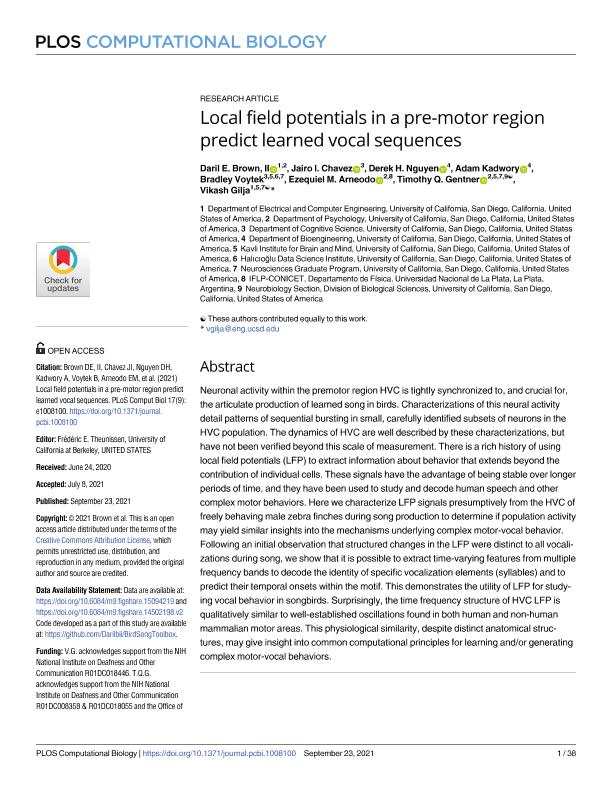Artículo
Local field potentials in a pre-motor region predict learned vocal sequences
Brown, Daril E.; Chavez, Jairo I.; Nguyen, Derek H.; Kadwory, Adam; Voytek, Bradley; Arneodo, Ezequiel Matías ; Gentner, Timothy Q.; Gilja, Vikash
; Gentner, Timothy Q.; Gilja, Vikash
 ; Gentner, Timothy Q.; Gilja, Vikash
; Gentner, Timothy Q.; Gilja, Vikash
Fecha de publicación:
09/2021
Editorial:
Plos
Revista:
PLOS Computational Biology
e-ISSN:
1553-7358
Idioma:
Inglés
Tipo de recurso:
Artículo publicado
Clasificación temática:
Resumen
Neuronal activity within the premotor region HVC is tightly synchronized to, and crucial for, the articulate production of learned song in birds. Characterizations of this neural activity detail patterns of sequential bursting in small, carefully identified subsets of neurons in the HVC population. The dynamics of HVC are well described by these characterizations, but have not been verified beyond this scale of measurement. There is a rich history of using local field potentials (LFP) to extract information about behavior that extends beyond the contribution of individual cells. These signals have the advantage of being stable over longer periods of time, and they have been used to study and decode human speech and other complex motor behaviors. Here we characterize LFP signals presumptively from the HVC of freely behaving male zebra finches during song production to determine if population activity may yield similar insights into the mechanisms underlying complex motor-vocal behavior. Following an initial observation that structured changes in the LFP were distinct to all vocalizations during song, we show that it is possible to extract time-varying features from multiple frequency bands to decode the identity of specific vocalization elements (syllables) and to predict their temporal onsets within the motif. This demonstrates the utility of LFP for studying vocal behavior in songbirds. Surprisingly, the time frequency structure of HVC LFP is qualitatively similar to well-established oscillations found in both human and non-human mammalian motor areas. This physiological similarity, despite distinct anatomical structures, may give insight into common computational principles for learning and/or generating complex motor-vocal behaviors.
Palabras clave:
Neuroscience
,
Birdsong
,
Brain Machine Interfaces
Archivos asociados
Licencia
Identificadores
Colecciones
Articulos(IFLP)
Articulos de INST.DE FISICA LA PLATA
Articulos de INST.DE FISICA LA PLATA
Citación
Brown, Daril E.; Chavez, Jairo I.; Nguyen, Derek H.; Kadwory, Adam; Voytek, Bradley; et al.; Local field potentials in a pre-motor region predict learned vocal sequences; Plos; PLOS Computational Biology; 17; 9; 9-2021; 1-38
Compartir
Altmétricas



